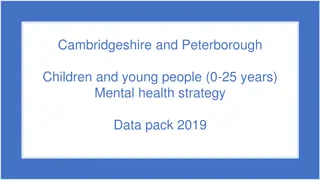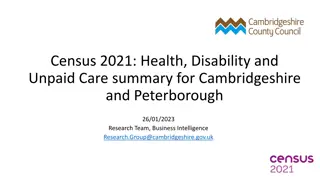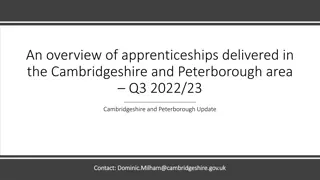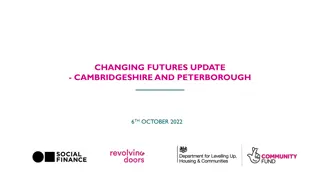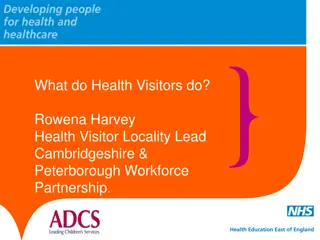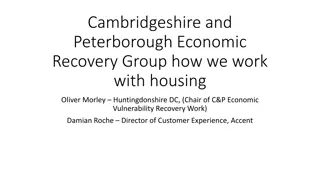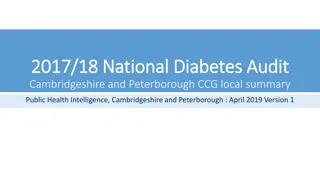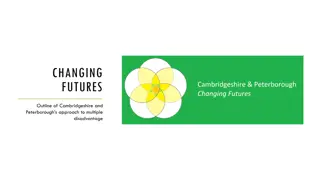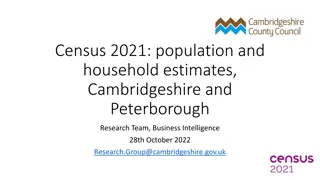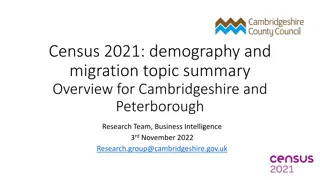Population Factors in Cambridgeshire and Peterborough: A Needs Assessment
This data pack explores population factors to support the needs assessment for mental health and learning disabilities in Cambridgeshire and Peterborough. It covers demographics, vulnerable groups, alcohol and drug use, smoking behaviors, access to mental health services, and premature mortality. Key findings include population growth trends by age groups and sex, as well as changes in ward populations based on the 2021 Census.
Download Presentation

Please find below an Image/Link to download the presentation.
The content on the website is provided AS IS for your information and personal use only. It may not be sold, licensed, or shared on other websites without obtaining consent from the author.If you encounter any issues during the download, it is possible that the publisher has removed the file from their server.
You are allowed to download the files provided on this website for personal or commercial use, subject to the condition that they are used lawfully. All files are the property of their respective owners.
The content on the website is provided AS IS for your information and personal use only. It may not be sold, licensed, or shared on other websites without obtaining consent from the author.
E N D
Presentation Transcript
Cambridgeshire and Peterborough All Age Mental Health and Learning Disabilities Needs Assessment Chapter 2: Population factors
Table of Contents Table of Contents Population demographics Vulnerable groups Alcohol and drug use Smoking and health behaviours Access to mental health services Premature mortality in adults with severe mental illness
Map of Cambridgeshire and Peterborough Introduction This data pack has been produced on population factors to support the Cambridgeshire and Peterborough all age mental health and learning disabilities needs assessment. Colour coding and abbreviations used: Key: Statistically significantly worse than England Statistically similar to England Statistically significantly better than England Cambridgeshire County Council CCC Office for Health Improvement and Disparities OHID Office for National Statistics ONS Annual Population Survey APS Department for Education DfE Quality and Outcomes Framework QOF
Population Demographics Population Demographics
Census 2021 provisional population, by ward Trumpington in Cambridge, Huntingdon North in Huntingdonshire, and the East, Central, and Ravensthorpe wards in Peterborough have the highest population in the 2021 census. In Census 2021, the highest percentage increase in population is seen in Trumpington in Cambridge, St Neots East in Huntingdonshire, Longstanton in South Cambridgeshire, and Hargate & Hempsted and Stanground South wards in Peterborough compared to the 2011 Census.
Population by sex and age group, Cambridge The key trends for Cambridge shown in the population pyramid are that population growth has been more evenly spread across the age groups, with only a notable decrease in population for the 0-4 and 85-89 age groups. In Census 2021, female population declined in the 80-89 age group, while both male and female population declined in the 0-4 age group compared to the 2011 Census. The highest percentage of usual residents are among the 25 to 49 year olds.
Population by sex and age group, East Cambridgeshire The key trends for East Cambridgeshire shown in this chart are some very notable population decreases between Census 2011 and 2021, in particular the 0-4 age group and the 20-49 age groups. In contrast, there has been notable growth for the 5-14, 50-59 and 70-79 age groups. The highest percentage of usual residents are among the 35 to 64 year olds. The share of residents aged between 65 and 74 years increased by two percentage points between 2011 and 2021.
Population by sex and age group, Fenland The key trends for Fenland shown in this chart are some notable population decreases in the 15-24 and 40-49 age groups. In contrast, there has been notable growth for the 5-9, 25-34, 50-59 and 70-79 age groups. The highest percentage of usual residents are among the 50 to 64 year olds (21%).
Population by sex and age group, Huntingdonshire The key trends for Huntingdonshire shown in this chart are some notable population decreases in the 0-4, 15-24 and 40-49 age groups. In contrast, there has been notable growth for the 25-39, 50-59 and 70-79 age groups. 1.9 percentage points increase is seen for 65-74 and 75-84 age groups each between 2011 and 2021.
Population by sex and age group, South Cambridgeshire The key trends for South Cambridgeshire shown in this chart are some notable population decreases in the 0-4, 20-24 and 60-64 age groups. In contrast, there has been notable growth for the 5-14, 50-59 and 70-79 age groups. The highest percentage of usual residents are among the 35 49 (21.5%) and 50 64 (19.9%) year olds. The share of residents aged between 65 and 74 years increased by 1.4 percentage points between 2011 and 2021.
Population by sex and age group, Peterborough The key trends shown in this chart are that Peterborough has seen population increases for all age groups except for the 20-24 age group, which has decreased. As with Cambridge, growth is more evenly spread between age groups, with notable population increases for the 5-14 and 30-39 age groups. The highest percentage of usual residents are among the 35 to 49 year olds (21.5%). An increase of 0.9 percentage points is seen in 65 74 year olds since 2011.
Usual resident population % change in usual resident population, Census 2001 to 2021 % change in by age group, Census 2011 to 2021 From Census 2011 to 2021, Cambridge (17.6%) and Peterborough (17.5%) had the highest proportion of increase in the usual resident population. However, East Cambridgeshire (4.7%) showed the least increase in its usual resident population from Census 2011 to 2021. The percentage change in usual resident population from Census 2011 to 2021 is higher than the national average in all areas across Cambridgeshire and Peterborough, except East Cambridgeshire (which is lower) and Huntingdonshire (which is similar). In Census 2021, the highest increase in the resident population is seen in Peterborough for 0 19 years, in Cambridge for 20 64 years, and in Huntingdonshire for 65 years and over compared to the previous Census. Since 2011, the population among those 65 and older has had the highest increase among all age groups in all areas except Cambridge.
Percent of population aged 3 years and above by proficiency in English, Census 2021 The proportion of residents (aged 3 years and over) whose main language is English varies widely across Cambridgeshire and Peterborough, ranging from 80.0% in Cambridge to 95.1% in East Cambridgeshire, while in Peterborough it is also 80%. The proportion of residents who cannot speak English well or at all in Peterborough (4.5%) is higher compared to all the districts in Cambridgeshire.
Percent of population by ethnic group, Census 2021 South Ethnic Group England East of England Peterborough Cambridge East Cambridgeshire Fenland Huntingdonshire Cambridgeshire Asian, Asian British or Asian Welsh 9.6% 6.4% 14.3% 14.8% 1.9% 1.2% 3.2% 5.8% Black, Black British, Black Welsh, Caribbean or African 4.2% 2.9% 4.1% 2.4% 0.8% 0.8% 1.5% 1.2% Mixed or Multiple ethnic groups 3.0% 2.8% 3.5% 5.1% 2.1% 1.4% 2.2% 2.8% Other ethnic group 2.2% 1.4% 2.7% 3.1% 0.7% 0.7% 0.7% 1.1% White 81.0% 86.5% 75.4% 74.5% 94.5% 95.9% 92.4% 89.0% White of which White: UK 73.5% 78.5% 59.5% 53.0% 86.5% 85.9% 85.2% 79.6% White of which 7.5% 8.0% 15.9% 21.5% 8.0% 10.0% 7.2% 9.4% White: Other ethnic group In Peterborough and Cambridge, the proportion of the population who identify as "Asian, Asian British, or Asian Welsh" is substantially higher than the national and East of England averages; for all other ethnic groups except "White," Peterborough and Cambridge are similar to the national averages. The proportion of "White" ethnic group in East Cambridgeshire, Fenland, and Huntingdonshire is substantially higher than the national average, whereas the proportions of "Asian, Asian British, or Asian Welsh" and "Black, Black British, Black Welsh, Caribbean, or African" ethnic groups are notable lower than the national averages in these areas.
Gypsy, Roma and Traveller population, Census 2021 All usual resident population Gypsy, Roma or Traveller (GRT) population Proportion of GRT population (%) Area Name Cambridge 145,674 998 0.7 East Cambridgeshire 87,762 383 0.4 Fenland 102,462 775 0.8 Huntingdonshire 180,832 401 0.2 South Cambridgeshire 162,118 656 0.4 Cambridgeshire 678,849 3,214 0.5 Peterborough 215,671 1,565 0.7 East of England 6,335,074 18,905 0.3 England 56,490,048 167,015 0.3 The proportion of Gypsy, Roma and Traveller population in all Cambridgeshire districts and Peterborough is higher than the regional and national averages, except Huntingdonshire which is lower.
Percent of population by country of birth, Census 2011 and 2021 Census 2011 Census 2021 Cambridge 70.6% 29.4% Cambridge 62.0% 38.0% East Cambridgeshire 90.2% 9.8% East Cambridgeshire 88.2% 11.8% Fenland Fenland 91.4% 8.6% 87.5% 12.5% Huntingdonshire Huntingdonshire 87.6% 12.4% 90.4% 9.6% South Cambridgeshire 83.8% 16.2% South Cambridgeshire 88.9% 11.1% Peterborough 71.8% 28.2% Peterborough 79.4% 20.6% 0.0% 10.0% 20.0% 30.0% 40.0% 50.0% 60.0% 70.0% 80.0% 90.0% 100.0% 0.0% 10.0% 20.0% 30.0% 40.0% 50.0% 60.0% 70.0% 80.0% 90.0% 100.0% UK Outside UK UK Outside UK International migration has continued to shape the populations of Cambridgeshire and Peterborough. The proportion of Cambridge and Peterborough residents born outside the UK has increased from 7.6% to 8.6%. In Cambridge, the population born outside the UK represents 38.0% of the total population, compared to 29.4% at the 2011 Census. In Peterborough, the population born outside the UK represents 28.2% of the total population, compared to 20.6% at the 2011 Census. In other Cambridgeshire districts, the numbers of usual residents born outside the UK have increased by 2.0% to 5.1%.
Percent of population ages 16 years and over by sexual orientation, Census 2021 In most districts the proportions of the population aged 16 years and over responding that they are asexual, bisexual, gay or lesbian, pansexual, queer, or other sexual orientation apart from straight or heterosexual, were generally very similar to national averages. In Cambridge a greater proportion of the population aged 16 years and over responded that they are bisexual, 3.8% compared to the England average of 1.3%, and gay or lesbian, 2.7% compared to the England average of 1.5% The proportion of the population aged 16 years and over responding that they are straight or heterosexual in most Cambridgeshire districts and Peterborough, was just slightly below the England (89.4%) average. In Cambridge the proportion was much lower at 80.6% compared to a range of 90.0% (Fenland, South Cambridgeshire) to 91.1% (Huntingdonshire) in the other districts of Cambridgeshire.
Percent of population ages 16 years and over by gender identity, Census 2021 In Cambridge, 89.7% identified their gender as the same as their sex registered at birth compared to a range of 93.1%, Fenland, to 94.9%, Huntingdonshire, in the other districts of Cambridgeshire and compared to the England (93.5%) averages. In Fenland, 0.4% identified their gender as different to their sex registered at birth without giving their specific identity compared to the Cambridgeshire average, 0.1%, and the East of England and England averages of 0.2%. In Peterborough a slightly lower proportion, 92.0%, identified their gender as the same as their sex registered at birth, compared to the England average. A slightly higher proportion, 0.6%, identified their gender as different from their sex registered at birth without giving their specific identity compared to the England average.
Highest level of qualification, Census 2021 In Cambridgeshire and Peterborough 17% of normal residents aged 16 and over had no formal qualifications. This was a lower proportion than both the East of England (18%) and England (18%) as a whole. Looking at individual local authorities these proportions were higher than England in Fenland (26%) and Peterborough (22%). In all other Cambridgeshire and Peterborough local authorities that proportions were lower than England as a whole and were lowest in Cambridge City (10%) and South Cambridgeshire (12%)
Economic activity status, Census 2011 and 2021 In 2021, all local authorities in Cambridgeshire and Peterborough have seen increases in economic inactivity compared to the 2011 Census.
Economic inactivity by reason, Census 2011 and 2021 Being retired is the reason given by the majority of economically inactive residents across Cambridgeshire and Peterborough (54.5%) with the exception of Cambridge where most economically inactive residents are students (50.8%). In 2021 census, a decline is seen in the proportion of people who are economically inactive due to long-term sickness or disability in all areas across Cambridgeshire and Peterborough.
Socio-economic classification, Census 2021 In Cambridgeshire and Peterborough, the top three socio-economic classifications are Lower managerial, administrative and professional occupations (20.0%), Higher managerial, administrative and professional occupations (16.2%) and Routine occupations (12.5%). Routine occupations was the top socio-economic classification in Fenland (19.1%) and Peterborough (18.5%), whereas in other Cambridgeshire districts it s either lower or higher managerial, administrative and professional occupations.
Household composition, Census 2011 and 2021 In 2021, the percentage of households including a couple with dependent children and no children decreased by 2.8 and 2.1 percentage points since the 2011 Census. The percentage of households including a lone parent in East Cambridgeshire increased by 1.7 percentage points from Census 2011. The proportion of one person households of Aged 66 years and over and Other categories increased by 0.9 to 1.1 percentage points respectively than the 2011 Census. The percentage of households including a lone parent in Cambridges increased by 1.2 percentage points since the 2011 Census. The proportion of one person households of Aged 66 years and over and Other categories decreased in 2021 compared to the 2011 Census.
Household composition, Census 2011 and 2021 In 2021, the percentage of households including a couple with dependent children and no children decreased by 1.6 percentage points since the 2011 Census. The percentage of households including a lone-parent in Fenland increased by 0.9% percentage points from Census 2011. In Census 2021, the proportion of one person households of Aged 66 years and over was similar to the 2011 Census and one-person household: Other had an increase from 14.2% in 2011 to 14.6% in 2021. Of Huntingdonshire households, 19.9% included a couple but no children in 2021, down from 22.1% in 2011. The proportion of one person households of Aged 66 years and over and Other categories increased by 1.7 and 0.7 percentage points since 2011. The percentage of households including a lone-parent increased by 0.8% percentage points from 2011.
Household composition, Census 2011 and 2021 The proportion of one person households of Aged 66 years and over and Other categories increased by 0.8 and 0.9 percentage points since 2011. The percentage of households including a couple without children in South Cambridgeshire decreased by 3.3 percentage points. The percentage of households including a lone-parent increased to 8.2% from 6.8% in 2011. The percentage of households including a couple without children in Peterborough fell from 17.6% to 15.9%. The percentage of households including a lone-parent increased to 12.6% from 11.2% in 2011, an increase of 1.4 percentage points.
Proportion of households by occupancy rating for bedrooms, Census 2021 The proportion of households classed as having the right number of bedrooms for its occupants is 22.8% of total households in Cambridgeshire, ranging from 18.4% in South Cambridgeshire to 35.3% in Cambridge, and being 28.6% in Peterborough, compared to the East of England average of 25.2% and national average of 26.8%. In Cambridgeshire 6,714 households (2.4% of total) had fewer bedrooms than required and so are classed as overcrowded, compared to 7,531 households (3.0% of total) in 2011, this is lower than the national figure of 4.3%. Cambridge has the highest proportion of overcrowded households at 4.5% in Cambridgeshire. In Peterborough 5,128 households (6.1%) had fewer bedrooms than required, compared to 3,807 (5.1%) in 2011.
General Health, Census 2021 General Health (Age standardised): % of population Good or very good health is reported most highly in South Cambridgeshire (85.9%) and East Cambridgeshire (84%), this is higher than England (81.7%) and the East of England (82.9%). The lowest level of good or very good health is reported in Fenland (79%) and Peterborough (79.3%). Bad or very bad health is highest at 6% in both Fenland and Peterborough. This is higher than England 5.3% and the East of England 4.6%. Bad or very bad health is lowest in South Cambridgeshire (3.4%) and East Cambridgeshire (3.9%).
Disability, Census 2021 Disability (Age standardised): % of population In Cambridgeshire, 16.4% of residents report as being disabled, this is lower than East of England (16.6%) and England (17.7%). South Cambridgeshire has the lowest proportion of residents reporting as disabled with 14.8%. East Cambridgeshire (15.9%) also has a lower proportion than the East of England and England. Huntingdonshire (16.7%), Peterborough (18.3%) and Fenland (19.6%) have a higher proportion than the East of England and England.
Disability, Census 2021 Number of disabled people in households Fenland has the highest proportion of homes with at least 1 disabled person resident (35.7%). Fenland is the only area with a higher proportion than England.
Unpaid care, Census 2021 Unpaid care (non age standardised) South Cambrid geshire 2011 South Cambridg eshire 2021 East East Cambridge 2011 Cambridge 2021 Fenland 2011 Fenland 2021 Huntingdon shire 2011 Huntingdon shire 2021 Peterborough 2011 Peterborough 2021 Cambridge shire 2011 Cambridge shire 2021 Unpaid Care Cambridge shire 2011 Cambridge shire 2021 Provides No unpaid care 92.1% 93.7% 90.1% 91.4% 88.9% 90.4% 90.3% 91.7% 90.4% 91.9% 89.9% 91.6% 90.3% 91.9% Provides 1 to 19 hours unpaid care a week 5.8% 3.7% 6.8% 4.9% 6.5% 4.2% 6.6% 4.5% 5.8% 3.6% 7.5% 5.1% 6.7% 4.5% Provides 20 to 49 hours unpaid care a week 0.8% 1.1% 1.1% 1.4% 1.6% 2.1% 1.1% 1.4% 1.4% 1.9% 0.9% 1.3% 1.1% 1.4% Provides 50 or more hours unpaid care a week 1.3% 1.5% 2.0% 2.3% 3.1% 3.4% 2.0% 2.4% 2.4% 2.5% 1.6% 2.0% 1.9% 2.2% The proportion of residents providing no unpaid care has risen from 2011 to 2021 across all areas of Cambridgeshire and Peterborough. Breakdown of those providing unpaid care shows an unexpected increase in number of residents providing more hours of care in 2021 than in 2011. These trends are seen in the East of England and nationally.
School pupil characteristics, Academic year 2021/22 Proportion of school pupil by ethnic group Proportion of school pupil by language White British 85% 90% Traveller of Irish heritage 80% White Irish 65% 70% Gypsy/Roma 60% Proportion 50% Any other White background 40% 34% Pakistani 30% Indian 14% 20% Asian Chinese 10% 1% 1% 0% Bangladeshi Known or believed to be English Known or believed to be other than English Language unclassified Any other Asian background Black Caribbean Cambridgeshire Peterborough Black Black African In Peterborough, the proportion of the school pupils who identify as "Asian (17.5%) and Black (4.8%) ethnic groups was substantially higher than Cambridgeshire (5.4% and 1.5% respectively) during the academic year 2021/22. The proportion of Mixed ethnic group in Peterborough was 1.5% higher than in Cambridgeshire. The proportion of school pupils whose first language is known or believed to be other than English in Peterborough (34%) is substantially higher than Cambridgeshire (14%). Any other Black background White and Black Caribbean White and Black African Mixed White and Asian Any other Mixed background other ethni grou Any Any other ethnic group p c assifi Uncl ed Unclassified 0% 10% 20% 30% 40% 50% 60% 70% 80% Proportion Peterborough Cambridgeshire








